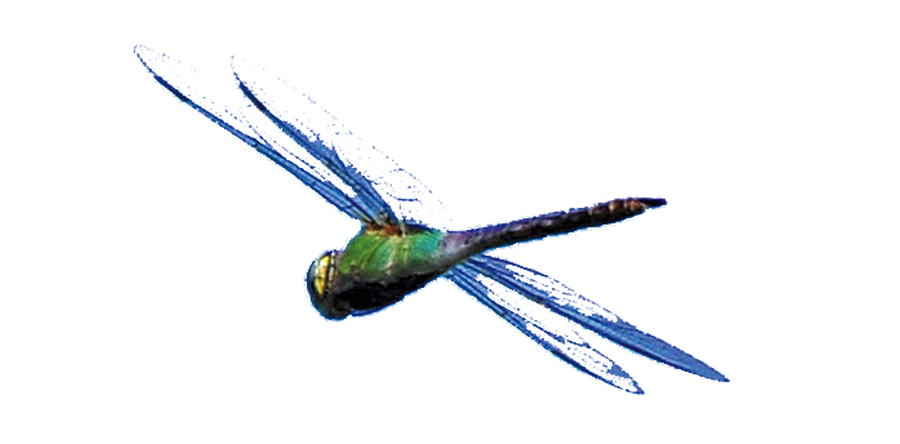One of the things I most enjoy about Iowa’s early duck seasons – in addition to the ducks, of course – are all the sights and sounds provided by the vast diversity of life forms that make the autumn marsh their home.
Some sights are commonplace. Others are seldom observed. My latest best example of the latter occurred near the end of this year’s teal season. Ducks are most active on breezy mornings, but on this day the waters were dead calm. And although the weather held little promise for hunting success, I’ve learned to never sleep in if you have a chance to be on the marsh.
The morning began with a spectacularly colorful sunrise. But as expected, most of the teal were sitting tight. Considering the complete lack of wind, the corresponding lack of ducks came as no surprise. What did come as a surprise, was when a giant green darner dragonfly came zooming out of the early morning mist. Dragonflies are cold blooded, solar powered creatures who usually prefer to lay low until warming sunlight brings their batteries to full charge. Seemed strange to see one on the wing during the coolest hour of the day.
I had just turned my attention back to the decoys when, like a miniature drone, a second darner rose from the nearby rushes. The dragonfly was followed by another, and then another. Connecting the dots, I suddenly suspected that I was on hand for a classic darner emergence.
Like all dragonflies, darners begin life as underwater nymphs called naiads. Predacious beyond their size, the bright green nymphs prowl the marsh’s mucky bottom devouring almost anything they can get their claws on – mostly other insects – but also bigger game including tadpoles and small fish. Growing throughout the warm weather season, naiads transform into the familiar adults during late summer and early fall.
After spending their entire lives beneath the surface, whole year classes of nymphs may simultaneously leave the water to climb the stalks of cattail and other aquatic plants. During a classic emergence, the numbers become staggering as hundreds, or sometimes thousands, of naiads conduct a mass exodus from the water. Once the climb is complete, the naiad’s skin stretches tight and then splits down the back as an adult dragonfly emerges. The dragonfly’s transformation is no less mysterious or dramatic than when a caterpillar becomes a butterfly.
Not all hatches are created equal. The one I was observing on this occasion would become the largest emergence I have seen firsthand. There may have been hundreds of darners that emerged in the immediate vicinity, and the numbers undoubtedly reached into the thousands across the entire wetland complex.
As is the case with emerging butterflies, newly formed adult dragonflies are weak and fragile. Their pulpy bodies are easily damaged; their wings are short and useless. But the transition from nymph to armor clad adult is amazingly rapid as exterior exoskeletons harden and wings grow. The wings of emerging dragonflies mature so rapidly, in fact, that you can watch the change. As soon as the transparent wings are sufficiently cured, the darner takes to skies.
Forever forsaking their former underwater lifestyles, adult darners now rule the sky – catching and devouring flying insects with spectacular bursts of speed. Mosquitoes are a favorite target, which is why dragonflies are commonly referred to as Mosquito Hawks.
My fondest recollection of the Mosquito Hawk’s aerial prowess occurred during a late summer afternoon as I helped my uncle Virgil Lovik bale hay at his farm near Joice. As a 16-year-old teen, my sole job was to neatly stack the bales atop a trailing wooden flat rack as soon as the mechanical baler spit them out. As we baled our way across the field, a constant swarm of insects would rise from the fragrant alfalfa windrows. Without fail, our activity would draw a hungry crowd of barn swallows, all eager to cash in on the bountiful supply of flying insects. Occasionally, the baler drew other winged hunters as well.
The most dramatic example occurred late one afternoon when an elegant green darner appeared next to the swaying hay rack. For several seconds the darner hovered in place; curiously sizing me up with its bulging set of compound eyes. The insect suddenly blasted skyward, hit the brakes, and then returned to its position beside the rack.
Only then did I see the reward of its effort, a plump mosquito currently held in the dragonfly’s front legs. Although the hovering darner appeared to be stationary, the insect was maintaining a steady position as it kept pace with the baler. Turning its attention back to the mosquito, the dragonfly quickly maneuvered its prey into a position where its pincher-like mouth parts could go to work. What followed was not a pretty sight. In less time than it takes to tell, the hapless mosquito had been sliced, diced, dewinged, shredded, and swallowed. As soon as the snack was finished, the dragonfly blasted forward again. This time, I got to see it make the kill — another plump, blood sucking mosquito.
More dragonflies soon appeared until hundreds of winged predators had converged above the field. It was unlike anything I had ever seen. Everywhere you looked, hunting dragonflies filled the afternoon sky.
The table was set and, without further ado, the feast began. Hovering, darting, grasping, and shredding — the darners were making their own brand of hay. I discovered that the best way to observe a successful hunt was to pick a single dragonfly and then try to stay with it. Dramatic results were never more than seconds away.
I had become witness to a predatory blood bath of catastrophic proportions. The carnage was without parallel. Gnats and mosquitoes were dying by the thousands.
A sudden bump on the hayrack and a shout from the tractor jarred me back to reality. I guess the show had been even better than I realized. I had completely missed the last two hay bales as they hit the rack. A third bale lay broken beneath the wagon. I’m glad that my Uncle Virgil was an even tempered Norwegian.
Enjoy more wildlife tales online at Washburn’s Outdoor Journal at iawildlife.org/blog





